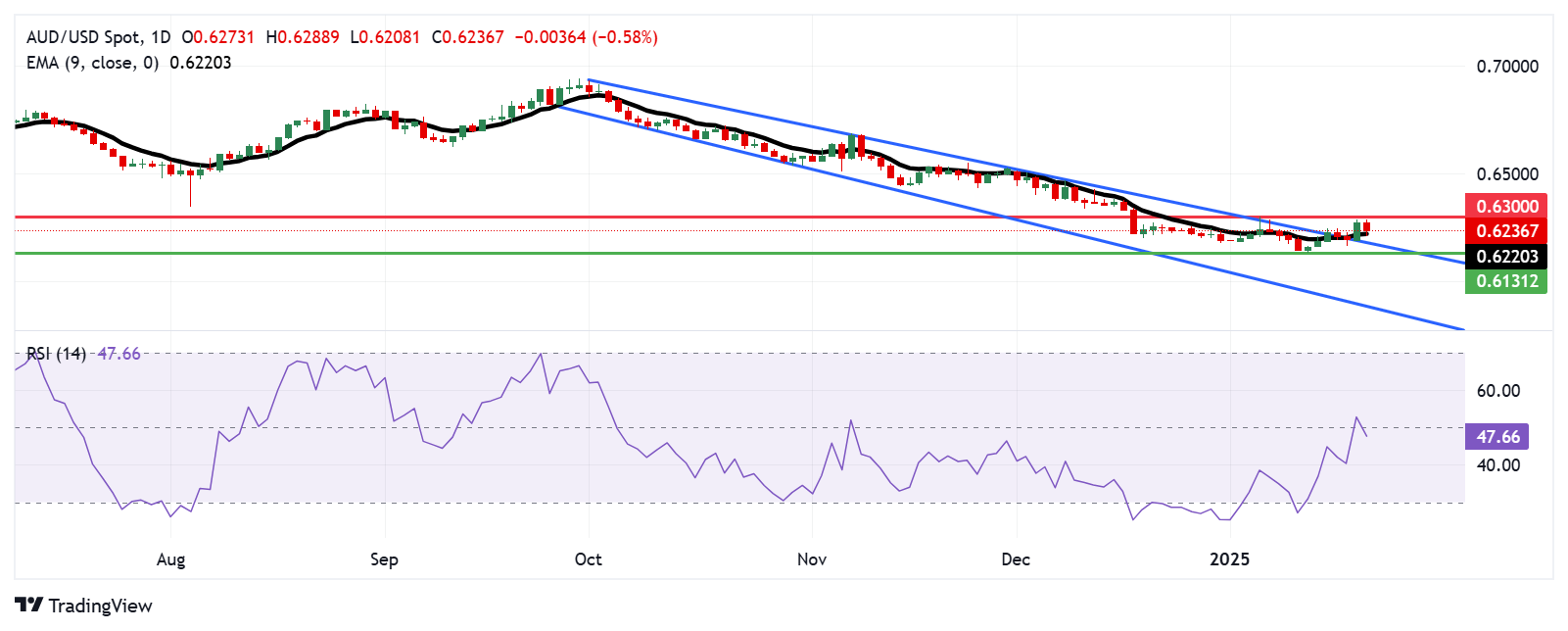- The Australian Dollar loses ground due to increased risk aversion as traders focus on Trump’s economic policies, including tariffs.
- The S&P/ASX 200 Index rose to nearly 8,400, reaching its highest level in six weeks.
- President Trump intends to instruct federal agencies to review tariff policies and assess the relationships with Canada, Mexico, and China.
The Australian Dollar (AUD) pares back its recent gains on Tuesday after a strong performance in the previous session. Despite this, the AUD/USD pair advanced as the US Dollar (USD) weakened, with traders closely watching for updates on US President Donald Trump’s economic policies, particularly regarding tariffs.
The S&P/ASX 200 Index climbed to nearly 8,400 on Tuesday, reaching its highest level in six weeks. This rally came in the wake of Donald Trump’s second-term inauguration, as markets reacted positively to his decision not to announce any new tariffs.
Traders increasingly anticipate that the Reserve Bank of Australia (RBA) could begin cutting interest rates as early as next month. This sentiment is driven by softer core inflation data, which has dropped to its lowest level since the fourth quarter of 2021, approaching the RBA’s target range of 2% to 3%. Attention is now turning to Australia’s upcoming quarterly inflation report, scheduled for release next week, as it may provide further insights into the likely path of interest rates.
The People’s Bank of China (PBOC) announced on Monday that it would keep its Loan Prime Rates (LPRs) unchanged. The one-year Loan Prime Rate (LPR) remains at 3.10%, while the five-year LPR stands at 3.60%. Since China and Australia are close trading partners, any shifts in China’s economy could have an impact on Australian markets.
Australian Dollar could appreciate as Trump refrains from announcing new tariffs
- The US Dollar Index (DXY), which tracks the performance of the US Dollar against six major currencies, rises to around 108.50 at the time of writing. However, the Greenback faced headwinds following a Bloomberg report indicating that President Donald Trump will not immediately announce new tariffs after his inauguration on Monday. Instead, Trump plans to direct federal agencies to review tariff policies and the United States’ trade relationships with Canada, Mexico, and China.
- The US Federal Reserve (Fed) is expected to keep its benchmark overnight rate steady in the 4.25%-4.50% range at its January meeting. However, investors believe Trump’s policies could drive inflationary pressures, potentially limiting the Fed to just one more rate cut. This could help cushion the USD against significant losses in the near term.
- US Retail Sales rose by 0.4% MoM in December, reaching $729.2 billion. This reading was weaker than the market expectations of a 0.6% rise and lower than the previous reading of a 0.8% increase (revised from 0.7%).
- The US Consumer Price Index increased by 2.9% year-over-year in December, up from 2.7% in November, aligning with market expectations. Monthly, CPI rose 0.4%, following a 0.3% increase in the previous month. US Core CPI, which excludes volatile food and energy prices, rose 3.2% annually in December, slightly below November’s figure and analysts’ forecasts of 3.3%.
- On Thursday, Chicago Federal Reserve Bank President Austan Goolsbee stated that he has grown increasingly confident over the past several months that the job market is stabilizing at a level resembling full employment, rather than deteriorating into something worse, according to Reuters.
- Scott Bessent, Donald Trump’s nominee for Treasury Secretary, emphasized the importance of maintaining the US Dollar as the world’s reserve currency for the nation’s economic stability and future prosperity. Bessent stated “Productive investment that grows the economy must be prioritized over wasteful spending that drives inflation,” per Bloomberg.
- The Federal Reserve reported in its latest Beige Book survey, released last week, that economic activity saw slight to moderate growth across the twelve Federal Reserve Districts in late November and December. Consumer spending increased moderately, driven by strong holiday sales that surpassed expectations. However, manufacturing activity experienced a slight decline overall, as some manufacturers stockpiled inventories in anticipation of higher tariffs.
Technical Analysis: Australian Dollar falls back below 0.6250 toward nine-day EMA
The AUD/USD pair trades near 0.6230 on Tuesday, attempting to fall back to the descending channel on the daily chart. A successful return would suggest that prevailing bearish bias is still in play. The 14-day Relative Strength Index (RSI) remains below the 50 level, signaling bearish bias is intact.
The AUD/USD pair tests the nine-day Exponential Moving Average (EMA) at 0.6220. A more substantial support level is located near the recent low at 0.6131 level. A break below this level could lead the AUD/USD pair to navigate the region around the lower boundary of the descending channel, around the 0.5890 mark.
On the upside, the AUD/USD pair could approach the psychological level of 0.6300.
AUD/USD: Daily Chart
Australian Dollar PRICE Today
The table below shows the percentage change of Australian Dollar (AUD) against listed major currencies today. Australian Dollar was the weakest against the Japanese Yen.
| USD | EUR | GBP | JPY | CAD | AUD | NZD | CHF | |
|---|---|---|---|---|---|---|---|---|
| USD | 0.34% | 0.33% | -0.23% | 0.79% | 0.45% | 0.45% | 0.13% | |
| EUR | -0.34% | 0.00% | -0.60% | 0.46% | 0.11% | 0.12% | -0.20% | |
| GBP | -0.33% | -0.00% | -0.63% | 0.46% | 0.11% | 0.12% | -0.20% | |
| JPY | 0.23% | 0.60% | 0.63% | 1.08% | 0.73% | 0.72% | 0.42% | |
| CAD | -0.79% | -0.46% | -0.46% | -1.08% | -0.35% | -0.34% | -0.65% | |
| AUD | -0.45% | -0.11% | -0.11% | -0.73% | 0.35% | 0.00% | -0.30% | |
| NZD | -0.45% | -0.12% | -0.12% | -0.72% | 0.34% | -0.00% | -0.32% | |
| CHF | -0.13% | 0.20% | 0.20% | -0.42% | 0.65% | 0.30% | 0.32% |
The heat map shows percentage changes of major currencies against each other. The base currency is picked from the left column, while the quote currency is picked from the top row. For example, if you pick the Australian Dollar from the left column and move along the horizontal line to the US Dollar, the percentage change displayed in the box will represent AUD (base)/USD (quote).
Australian Dollar FAQs
One of the most significant factors for the Australian Dollar (AUD) is the level of interest rates set by the Reserve Bank of Australia (RBA). Because Australia is a resource-rich country another key driver is the price of its biggest export, Iron Ore. The health of the Chinese economy, its largest trading partner, is a factor, as well as inflation in Australia, its growth rate and Trade Balance. Market sentiment – whether investors are taking on more risky assets (risk-on) or seeking safe-havens (risk-off) – is also a factor, with risk-on positive for AUD.
The Reserve Bank of Australia (RBA) influences the Australian Dollar (AUD) by setting the level of interest rates that Australian banks can lend to each other. This influences the level of interest rates in the economy as a whole. The main goal of the RBA is to maintain a stable inflation rate of 2-3% by adjusting interest rates up or down. Relatively high interest rates compared to other major central banks support the AUD, and the opposite for relatively low. The RBA can also use quantitative easing and tightening to influence credit conditions, with the former AUD-negative and the latter AUD-positive.
China is Australia’s largest trading partner so the health of the Chinese economy is a major influence on the value of the Australian Dollar (AUD). When the Chinese economy is doing well it purchases more raw materials, goods and services from Australia, lifting demand for the AUD, and pushing up its value. The opposite is the case when the Chinese economy is not growing as fast as expected. Positive or negative surprises in Chinese growth data, therefore, often have a direct impact on the Australian Dollar and its pairs.
Iron Ore is Australia’s largest export, accounting for $118 billion a year according to data from 2021, with China as its primary destination. The price of Iron Ore, therefore, can be a driver of the Australian Dollar. Generally, if the price of Iron Ore rises, AUD also goes up, as aggregate demand for the currency increases. The opposite is the case if the price of Iron Ore falls. Higher Iron Ore prices also tend to result in a greater likelihood of a positive Trade Balance for Australia, which is also positive of the AUD.
The Trade Balance, which is the difference between what a country earns from its exports versus what it pays for its imports, is another factor that can influence the value of the Australian Dollar. If Australia produces highly sought after exports, then its currency will gain in value purely from the surplus demand created from foreign buyers seeking to purchase its exports versus what it spends to purchase imports. Therefore, a positive net Trade Balance strengthens the AUD, with the opposite effect if the Trade Balance is negative.

